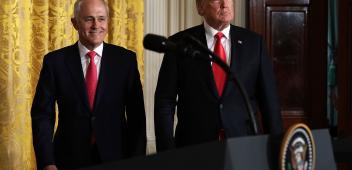Rajan had only just begun to overhaul India's financial sector
Originally published in the Nikkei Asian Review

Executive Summary
Raghuram Rajan has turned in his badge as governor of the Reserve Bank of India, effective from the end of his first term in September. For many observers of the checkered history of the global financial sector during the past decade, Rajan is a maverick hero. He was a professor at the free market-obsessed University of Chicago, yet he saw the fundamental weaknesses of globalized financial markets and spoke out boldly. At the central bankers' annual get-together at Jackson Hole in 2005, his predictions that global financial markets were headed for a fall provoked a vitriolic response from former U.S. Treasury Secretary Larry Summers, who accused him of being a "Luddite." Poignantly, this meeting was principally a retirement party for Alan Greenspan, the financial market's greatest (and most blinkered) advocate. Rajan was widely condemned as a party-pooper in 2005. Within three years, his views had turned out to be prophetic.
Now, Summers acknowledges that Rajan was one of the few central bank governors to make a difference. When Rajan arrived at the Reserve Bank of India three years ago, it was still stuck in a dirigiste mindset where the job of monetary policy was to fine-tune all aspects of the economy, weighing up the various pressures being brought to bear on it, lowering interest rates when the economy slowed and steering credit to favored areas (and favored borrowers).
Rajan promised to "build a bridge to the future, over the stormy waves produced by global financial markets." He switched the policy focus to concentrate on inflation control (the overriding objective of most central banks for the past three decades). His success on the macroeconomic front is clear. Inflation has halved, foreign exchange reserves are high, India is no longer seen by financial markets as one of the "fragile five" (as it was in 2013), and the nation has been recording the highest growth rate among large emerging economies.
BAD DEBTS. These are mighty achievements at the macro level. The task of fixing the financial sector at the micro level is harder still and has barely begun. The Indian banking sector is still dominated by the lumbering state banks, which account for 70% of lending. This is a very different challenge and one that will take decades to address. Rajan began the job, instituting the Asset Quality Review, which identifies previously hidden nonperforming bank loans. Bad debts and doubtful loans so far identified make up 17% of the state banks' portfolios. Special relationships exist between bankers and borrowers, and politics has intruded deeply in some cases in India.
These tensions, and the usual self-serving demands by business for lower interest rates, have created tensions between Rajan and the BJP government, with its powerful business lobby. Rajan has been outspoken, which has helped enormously in making monetary policy more transparent. He has not, however, confined his comments just to the narrow subject of monetary policy, and this is being held against him by his detractors. They will be happy if his successor keeps a low profile.
The institutional framework of the RBI is inimical to the sort of independence which is now regarded as the norm for central banks. The short tenure of the governor, and monetary policy decision-making by committee (in which it seems likely that the governor can be outvoted by government appointees), seem archaic by current global best-practice standards. Effective monetary policy requires a degree of independence from the government. It is not clear that the RBI has this. As the U.S. Federal Reserve chair noted more than half a century ago, the key task of the central bank is "to take away the punch bowl just when the party is getting good." This is never politically popular. The challenge of effective prudential supervision, with powerful vested interests on every side, is even more daunting.
Perhaps Rajan has had enough, after just three years. Earlier, he served only one five-year term as the International Monetary Fund's chief economist, and his plea that he is an academic at heart, more interested in intellectual ideas than in the practice, rings true: "I am an academic and I have always made it clear that my ultimate home is in the realm of ideas." But it seems that he was ready to take on another term at the RBI.
Perhaps sensing the difficult decision Rajan had to make, his old alma mater back in Chicago recently published an article on how outside appointments (Rajan in India and Stanley Fischer during his time as governor of the Bank of Israel) may be better placed than insiders to take on the most politically charged decisions faced by central banks. If this is true, the job remains half-finished in India.
It will take someone of Rajan's caliber to drive through the reforms that the Indian financial sector needs, if it is to support the continuation of rapid growth. If the politicians have their way, he will not be replaced by a similarly independent-minded outsider, but rather by an insider who is likely to have a more timid approach, while hard decisions are needed. Foreign financial sector commentators have asked whether Rajan's departure will adversely affect investor confidence and the inflow of foreign capital. Central bank watchers would ask a deeper but related question: whether the Indian financial sector and monetary policy framework can complete the necessary reforms that Rajan began.
Stephen Grenville is a nonresident fellow at the Lowy Institute for International Policy in Sydney and a former deputy governor of the Reserve Bank of Australia.



